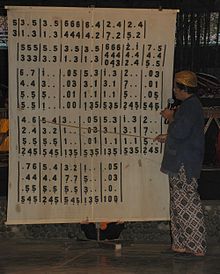Chevé numerical notation

The Chevé digit notation is a notation in digits. It was developed by the French Émile Chevé (* 1804, † 1864). The idea behind it is that you can write or print music on a printing press with the existing numeric letters or with a typewriter, so that no note symbols are required.
According to Chevé's number notation, melodies are not represented by notes , but by numbers in the sequence from 1 to 8. In the case of semitone steps upwards, the number is provided with a line leading from the bottom left to the top right; The numbers from 1 to 8 represent the tones of the octave from c 'to c' ', the tones of the next higher octave are represented by dots above the numbers, and lower octaves by analogy with dots below the numbers. The key of a piece of music results from a preceding specification (for example 2 = d ').
The Chevé numerical notation was introduced, for example, by Dutch missionaries in the Dutch-Indian colony (now Indonesia ), and is still in use there today in church hymn books and folk song collections. The West Javanese musical instrument Angklung , for example , is also played in numeric notation.
